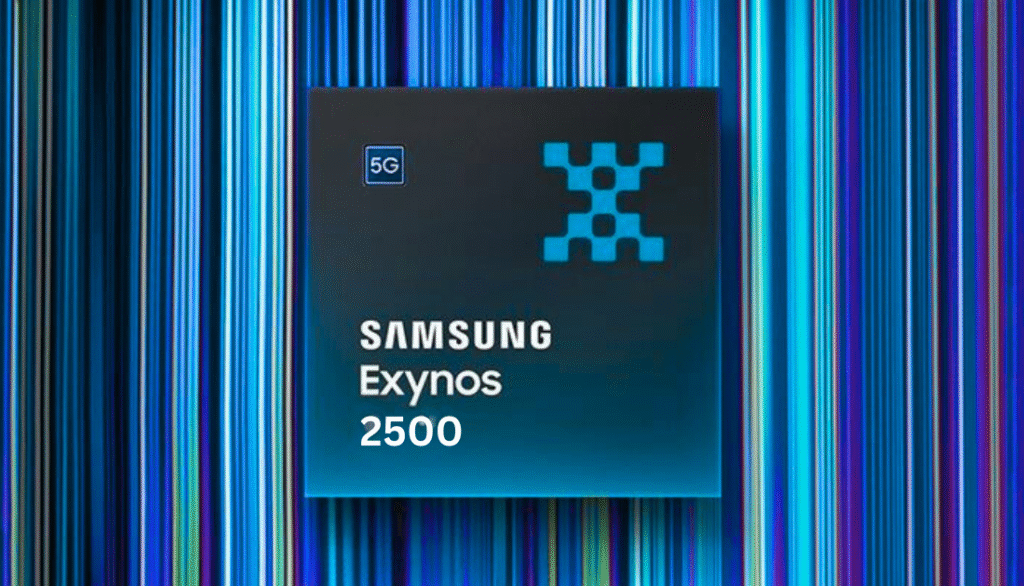Samsung has officially unveiled its most advanced mobile chipset yet—the Exynos 2500. Built on Samsung’s 3nm Gate-All-Around (GAA) process, the new SoC delivers improvements across performance, efficiency, AI capabilities, and connectivity.
Highlights
- 3nm GAA Process Debut: First Exynos SoC built on Samsung’s next-gen Gate-All-Around transistor tech, offering better thermal efficiency and power management.
- 10-Core CPU Architecture: New 1+7+2 layout with Cortex-X5 at 3.3GHz for high performance, delivering 15% faster speeds over the Exynos 2400.
- Graphics Power via AMD RDNA 3: Xclipse 950 GPU enables hardware ray tracing and up to 28% higher frame rates—optimized for mobile gaming.
- AI Performance Surge: Next-gen NPU supports 59 TOPS, boosting tasks like real-time translation, generative photo editing, and on-device AI apps.
- LEO Satellite Support: Native satellite communication enables emergency messaging and calls in no-network zones.
- Camera Upgrades: Supports up to 320MP sensors, multi-layer noise reduction, and AI-enhanced photo editing features—all handled on-device.
- High-End Display & Media: Up to 4K@120Hz or QHD+@144Hz, plus 8K video at 30fps, LPDDR5X RAM, and UFS 4.0 storage.
- Broad Connectivity Suite: Wi-Fi 7, Bluetooth 5.4, 5G (12.1 Gbps), NFC, USB 3.2—future-ready on all fronts.
- Early Benchmarks: Geekbench 6 scores (≈2,350 single-core, ≈8,070 multi-core) show solid, but not class-leading performance.
The Exynos 2500 is now in mass production, and industry speculation suggests it may debut in the upcoming Galaxy Z Flip 7, expected to launch at Samsung’s next Unpacked event.
3nm GAA Architecture and CPU Configuration
The Exynos 2500 is Samsung’s first SoC to leverage its 3nm GAA process, a next-gen transistor design that promises better power efficiency and thermal performance compared to FinFET-based predecessors. The chip features a 10-core CPU in a 1+7+2 configuration:
- 1× Cortex-X5 core at 3.3GHz
- 2× Cortex-A725 cores at 2.74GHz
- 5× Cortex-A725 cores at 2.36GHz
- 2× Cortex-A520 efficiency cores at 1.8GHz
Samsung claims this architecture delivers up to 15% faster CPU performance over the previous-generation Exynos 2400.
AMD RDNA 3 Integration
For graphics, the Exynos 2500 uses the Xclipse 950 GPU, powered by AMD’s RDNA 3 architecture. This enables hardware-accelerated ray tracing and up to 28% better frame rates, positioning the chip as a strong option for mobile gaming and graphics-intensive tasks.
59 TOPS and Enhanced NPU
AI performance sees a substantial boost through a next-generation NPU capable of 59 TOPS (trillion operations per second).
According to Samsung, this represents a 39% improvement in AI processing over its predecessor. On-device AI enhancements support real-time translation, generative AI image editing, camera optimization, and other tasks without requiring cloud processing.
Satellite Connectivity and Emergency Support
The Exynos 2500 introduces native Low Earth Orbit (LEO) satellite communication, allowing smartphones to support emergency messaging and calls in areas without cellular coverage.
This addition reflects a broader trend in smartphone SoCs focusing on reliability and critical communication features.
Photography & Imaging Capabilities
Samsung has also upgraded the chip’s Image Signal Processor (ISP) to support camera sensors up to 320 MP. The ISP includes features such as:
- Multi-layer noise reduction (MLNR)
- Enhanced spatial and temporal denoising
- Dynamic range compression
- On-device generative AI tools for editing, like object removal and background expansion
Display, Storage, and Connectivity
The Exynos 2500 supports high-end hardware features, including:
- 4K displays at 120Hz or Quad HD+ at 144Hz
- 8K video capture at 30fps
- LPDDR5X RAM and UFS 4.0 storage
- Wi-Fi 7, Bluetooth 5.4, 5G (up to 12.1Gbps), USB 3.2 Type-C, and NFC
Real-World Performance and Benchmarks
Despite Samsung’s internal claims of 15% CPU gains, early Geekbench 6 scores for the Exynos 2500 show mixed results:
- ≈2,350 single-core
- ≈8,070 multi-core
While this represents modest improvements—~17% in single-core and ~7% in multi-core over the Exynos 2400—the chip still trails behind competitors like Qualcomm’s Snapdragon 8 Gen 3 Elite and Apple’s A18 Pro.


